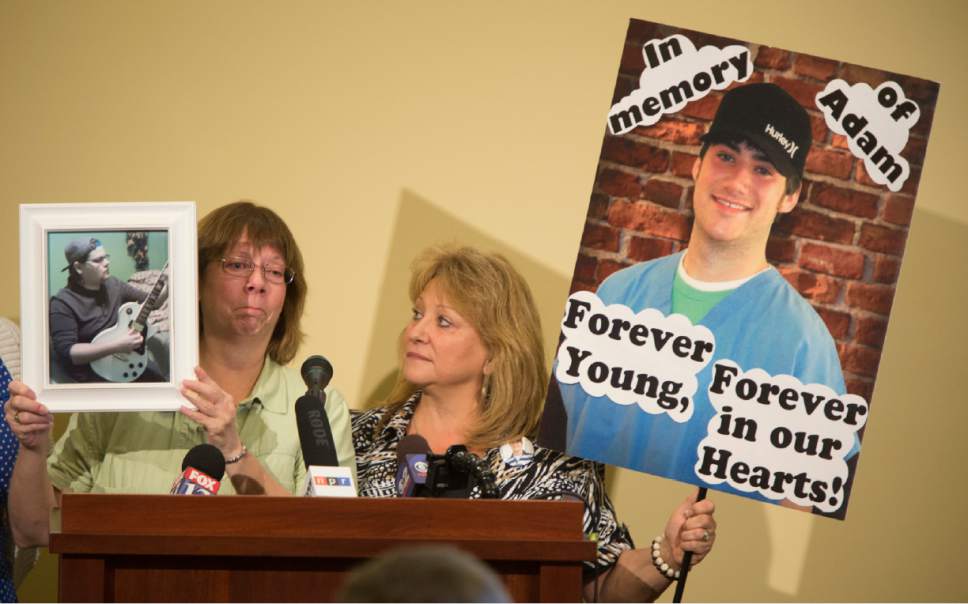This is an archived article that was published on sltrib.com in 2015, and information in the article may be outdated. It is provided only for personal research purposes and may not be reprinted.
More Utahns are dying because of prescription drugs.
Last year, 289 people died overdosing on opioid painkillers, according to preliminary data from the Utah Department of Health. That's up by about 5 percent from 2013, when the toll was 274. The pain meds caused more deaths than all other kinds of drugs, including heroin and cocaine.
The tally has made a steady climb in recent years, and one state legislator says she wants to see it drop. Rep. Carol Spackman Moss is proposing that the Legislature declare the state's opioid overdose problem a "medical emergency."
"It truly is a public health crisis," Moss said at a news conference to call attention to the push at the Capitol on Monday, a day of national overdose awareness. "We have to educate young people. We have to make them understand," said Moss, a former Olympus High School teacher who has lost a stepson and several former students to drug overdoses.
The Salt Lake City Democrat joined advocates and a half-dozen families who've lost sons and daughters to painkiller addiction.
The coming legislative session does not start until January, but Moss already has a draft resolution in the works. If successful, Moss says, such a move will stress the need for more public funding to equip first responders with prescription drugs that can reverse an overdose. She believes her Republican colleagues will support the resolution.
Rep. Ed Redd, a Logan Republican and physician, also joined Moss at the Capitol, saying he has seen the effects of opiate addiction as a counselor providing psychiatric help to inmates. Redd said he is starting to work on a separate legislative proposal to better assist friends and families seeking treatment for loved ones.
"This is not a crisis," Redd said. "This is a disaster."
The Legislature already has taken some steps in recent years to curb the deaths.
A 2014 Utah law allows concerned family members, friends and others to legally obtain naloxone, the substance that counters the effect of powerful opioids.
Since then, an initiative from Jennifer Plumb, a pediatrician at Primary Children's Hospital, has parceled out 400 "naloxone kits" containing vials of the substance. The free packages contain syringes and brochures on how to administer the medication. Without such programs, naloxone is reported to cost $40 to $50, with prices rising as more agencies and individuals seek the treatment. Insurance also may not cover the cost.
The national Centers for Disease Control appears to agree that more attention is needed in Utah. Last week, it effectively renewed and tripled a $1 million 2014 grant to help the department analyze and prevent overdoses.
As the new CDC grant rolls out, Utah will get $940,000 a year for the next three years.
"We had a great running start" with the first grant, said Anna Fondario, injury epidemiologist in the state's violence and injury prevention program. The new award, Fondario said, "completely expanded our focus of how we can address this problem."
For example, the department will be able to spend more time and resources tracking prescriptions, hospitalizations and deaths, Fondario said. The more detailed numbers will shed insight, she added, on where to focus prevention efforts.
The number of Utahns who've died from prescription painkiller overdoses has risen since legislative funding for a statewide prevention effort expired in 2010.
But it's still not as high as the peak year — 2007, when 326 Utahns died from painkiller overdoses.
In 2012, opioids caused about 260 deaths in the state, according to the health department.
The three top drugs involved were oxycodone, methadone and hydrocodone, which have different brand names. Most deaths were accidental.
At the Capitol on Monday, Moss also urged Gov. Gary Herbert, Utah legislators and law enforcement officials to call for safer pain medications and take steps to halt the flow of illicit drugs to Utah. Moss believes her Republican colleagues also will get behind the push.
Dennis Cecchini, who lost his 33-year-old son, Tennyson, in May to opiate addiction, said he and his wife found their son slumped over with no pulse soon after he left a treatment program. Cecchini was unaware of naloxone, which also goes by the brand name Narcan.
"He continued to self medicate, progressing from pills to heroine," Cecchini said. He believes more awareness and more personalized drug treatment are needed.
Fondario says the CDC awards will help the department determine whether recent legislation, including the naloxone measure, has helped reduce painkiller deaths.
She and her colleagues also will seek to analyze effects of a second 2014 law that grants some immunity from prosecution to bystanders who report someone has overdosed on prescription painkillers.
Kentucky, Oklahoma, Tennessee and West Virginia also got the initial grant. But CDC officers have not announced the full roster of recipients for this year.
Twitter:@anniebknox — Prescription opioid deaths in Utah, 2013-2014
2013 2014
Total 274 289
Age
18-24 years 23 14
25-34 years 64 64
35-44 years 62 83
45-54 years 71 72
55+ years 53 52
Sex
Male 140 147
Female 134 142
—-
Data Source: Utah Department of Health Prescription Drug Database. These figures include deaths in Utah, whether or not the patients were residents of Utah. The 2014 data also is preliminary. Deaths of individuals under age 18 are not included.





